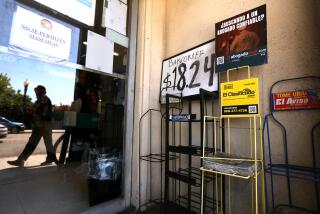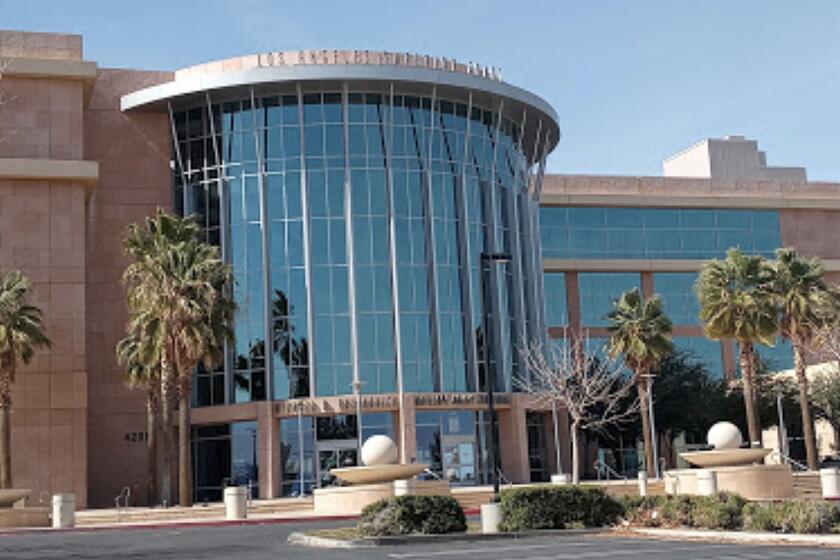Judges Halt O.C. Federal Trials to Review Jury Selection Policy : Courts: Defense attorneys say new method greatly reduces available pool, unfairly excluding minorities. Concern about right to be judged by one’s peers prompts a mistrial.
- Share via
SANTA ANA — Most jury trials for criminal cases in Santa Ana federal court have been temporarily halted, pending a review of a new jury-selection policy criticized by defense attorneys as excluding minorities.
Concerned that the constitutional right to judgment by one’s peers might be threatened, U.S. District judges declared a mistrial this week in one bank robbery case and postponed at least one drug trial until a review of the situation is finished.
In a third case involving another bank robbery, the defense attorney said Friday he will join the challenge to the newly imposed selection methods, which greatly reduced the number of counties from which prospective jurors are drawn for trials at the small federal courthouse here.
Traditionally, jurors in California’s central federal court district have been chosen from seven counties, from San Luis Obispo on the north to Orange on the south, ensuring a multiethnic pool for jury selection.
But in a policy that went into effect for the Santa Ana courthouse earlier this month, the geographical area from which jury pools are drawn was narrowed to Orange, Riverside and San Bernardino counties. It could not be immediately ascertained how many jury trials have been held under the new policy.
The new selection method was adopted in August by 26 of the Central District’s 28 judges and approved by the U.S. 9th Circuit Court of Appeals. Five federal judges are assigned to Santa Ana.
“The demographics of the entire jury pool is changed, obviously, if they limit the pool selection to the tri-county area,” said Santa Ana defense attorney C. Thomas McDonald, who opposes the change. “Every citizen is entitled to jury trial by a cross-section of the community.”
The review that got underway this week stemmed from a mistrial declared Tuesday by Judge Alicemarie Stotler, after federal Public Defender H. Dean Steward complained that the assembled jury pool for his bank robbery case was almost exclusively white.
Steward, who heads the Federal Public Defender’s Office in Santa Ana, said the group of 38 potential jurors gathered for his African-American client’s trial only contained three minorities, an Asian, a black and a Latino.
There was a good possibility, Steward contended, that not one of the minorities in the pool would get picked for the jury. “By the time we got to the 12th person, none of the minorities would have gotten on the panel,” he said.
In the drug case that was postponed, defense attorneys Terrence A. Roden of Los Angeles and James Brustman of Santa Ana challenged the jury selection method on behalf of their three Latino clients, who are accused of cocaine possession. Agreeing that the jury issue needed to be resolved before proceeding, District Judge Gary L. Taylor postponed the case pending resolution of Steward’s challenge.
“We are concerned that it will exclude minorities on a large scale, making it difficult for a minority to get a fair trial,” said Roden.
McDonald, who is representing an African-American scheduled to go to trial Nov. 2 on bank robbery charges, said he has notified the court that he plans to join in the defense challenges to the jury pool.
“My experience tells me a pool of people in which minorities are absent is particularly problematic when you have a minority client,” McDonald said, adding that he too would like his client’s trial postponed until the challenge is resolved.
Neither Stotler nor Taylor could be reached for comment Friday. Frank Galvan, the jury commissioner for the central district, Leonard A. Brosnan, the clerk of U.S. District Court, and Chief District Judge Manuel L. Real in Los Angeles also were unavailable.
Steward, who initiated the challenge to the new jury-selection process, said Stotler ordered him to prepare an analysis of the policy and present his findings to the court at a hearing set for Nov. 15.
It was not known what remedies might be considered if the new area from which the jury pool is drawn is found to be out of balance, but a return to the old system is not ruled out.
The rulings by Stotler and Taylor effectively halted criminal jury trials in their courts, and their decisions are not binding on the three other federal judges sitting in Santa Ana. With criminal jury proceedings under a cloud in Stotler’s and Taylor’s courts, however, defense attorneys said it was likely that other cases will similarly be halted or postponed.
Steward, who is a director of the Federal Bar Assn. of Orange County, said he is compiling census data and jury statistics that relate to the demographic and racial makeup of the people selected for jury service under the new policy.
“I believe it will result in juries that are significantly weighted with whites. I care about the exclusion of minorities that could happen. That is where the constitutional rub comes in,” he said.
The 1990 Census shows that Orange County is 64% Anglo, 23% Latino, 10% Asian and 1.6% African-American, with less than 1% people of other races. Riverside County is 65% Anglo, 26% Latino, 5% African-American, 3% Asian, and has less than 1% people of other races. San Bernardino County is 61% Anglo, 27% Latino, 8% African-American, 4% Asian, and has less than 1% people of other races.
The new policy, Steward said, apparently was adopted by the court without determining what the impact could be on juries, and without consulting the U.S. attorney’s office, the federal public defender or members of the county’s federal bar association.
Laurie Levenson, an associate law professor of legal ethics at Loyola Marymount University Law School, said federal jurors in the Central District are culled from voter registration rolls, while state courts pick jurors from both voter lists and state driving records.
The state process is widely assumed to result in greater minority representation on the jury panels, said Levenson, a former federal prosecutor.
“There have been concerns over the past few years that the process means there are fewer minorities on federal panels,” Levenson said.
The issue of racial representation of jurors has already been a controversial topic at Orange County Superior Court in Santa Ana, located just around the corner from the federal courthouse.
When the Orange County Grand Jury released a report in June that blamed illegal immigration for a wide variety of societal ills, Latino-rights advocates criticized the report as racist and blamed it on the lack of minority representation on that panel.
Several prominent Orange County defense attorneys are pursuing a challenge to indictments handed down by the grand jury, arguing that the indictments are unconstitutional because the panel does not adequately represent the community at large.
* GRAND JURY FALLOUT: Tay case lawyer claims bias in a bid to quash indictment. A38
More to Read
Sign up for Essential California
The most important California stories and recommendations in your inbox every morning.
You may occasionally receive promotional content from the Los Angeles Times.












